List of governors of Wisconsin
From Wikipedia, the free encyclopedia
The governor of Wisconsin is the head of government of Wisconsin[2] and the commander-in-chief of the state's army and air forces.[3] The governor has a duty to enforce state laws,[3] and the power to either approve or veto bills passed by the Wisconsin Legislature,[4] to convene the legislature,[3] and to grant pardons, except in cases of treason and impeachment.[5]
| Governor of Wisconsin | |
|---|---|
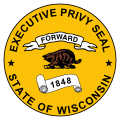 Gubernatorial seal | |
| Residence | Wisconsin Governor's Mansion |
| Term length | Four years, no term limits |
| Inaugural holder | Nelson Dewey |
| Formation | June 7, 1848 |
| Succession | Line of succession |
| Deputy | Lieutenant Governor of Wisconsin |
| Salary | $152,756 (2022)[1] |
| Website | governor |
Forty-four individuals have held the office of governor of Wisconsin since the state's admission to the Union in 1848, one of whom—Philip La Follette—served non-consecutive terms. Nelson Dewey, the first governor, took office on June 7, 1848. The longest-serving governor was Tommy Thompson, who took office on January 5, 1987, and resigned on February 1, 2001, a total of 14 years and 28 days. Arthur MacArthur Sr. had the shortest term: he was governor for a total of just 5 days—from March 21 to 25, 1856.[6] The current governor is Tony Evers, a Democrat who took office on January 7, 2019.[6]
List of governors
Summarize
Perspective
Initially after the American Revolution, parts of the area now known as Wisconsin were claimed by Virginia, Massachusetts and Connecticut; however, Virginia ceded its claim in 1784, Massachusetts in 1785 and Connecticut in 1786.[7] On July 13, 1787, the Northwest Territory, including the area now called Wisconsin, was formed; Wisconsin remained part of the territory until 1800.[8] The territorial governor during this period was Arthur St. Clair.[9] As parts of the Northwest Territory were admitted to the Union as states, Wisconsin became part of first the Indiana Territory (1800–1809), then the Illinois Territory (1809–1818), and then the Michigan Territory (1818–1836);[8] see the lists of governors of Indiana, of Illinois, and of Michigan for these periods.
Wisconsin Territory
Wisconsin Territory was formed on July 3, 1836. During the time of its existence, the Wisconsin Territory had three people appointed governor by the President of the United States, one of whom served non-consecutive terms.
When most of Wisconsin Territory was admitted as the state of Wisconsin, the remainder became unorganized territory. However, the citizens of the region maintained a territorial government, and even elected a delegate to the United States House of Representatives, essentially making it a de facto continuation of Wisconsin Territory.[10] As the region no longer had an official governor, Territorial Secretary John Catlin acted as governor of the region.[11]
| No. | Governor | Term in office[a] | Appointing President | |
|---|---|---|---|---|
| 1 |  |
Henry Dodge (1782–1867) [12] |
April 30, 1836[b] – September 13, 1841 (successor appointed) |
Andrew Jackson |
| Martin Van Buren | ||||
| 2 |  |
James Duane Doty (1799–1865) [16] |
September 13, 1841[c] – June 15, 1844 (successor appointed) |
John Tyler |
| 3 |  |
Nathaniel P. Tallmadge (1795–1864) [19] |
June 15, 1844[d] – April 8, 1845 (successor appointed) |
John Tyler |
| 4 |  |
Henry Dodge (1782–1867) [12] |
April 8, 1845[e] – June 23, 1848 (statehood) |
James K. Polk |
State of Wisconsin
Wisconsin was admitted to the Union on May 29, 1848. Since then, it has had 45 governors, one of whom served non-consecutive terms.[6]
Originally, governors of Wisconsin served for two-year terms, but in 1967 the state constitution was amended to change this to four.[2] Jeremiah McLain Rusk served 1 3-year term in the 1880s as the constitution was amended during his first term to move elections from odd to even years, and all officers were allowed to serve an extra year, rather than have their terms cut a year short. Patrick Lucey, elected in the 1970 election, was the first governor to serve a 4-year term.[6] Governors of Wisconsin are not term limited.
Lucius Fairchild, Jeremiah McLain Rusk, Robert M. La Follette, Emanuel L. Philipp, John J. Blaine, Walter J. Kohler Jr., Warren P. Knowles and Tommy Thompson are one of eight Wisconsin governors to have served three terms. Thompson is the only person to have won four terms having been elected in 1986 and re-elected in 1990, 1994 and again in 1998 before resigning in February 2001.
The state constitution provides for the election of a lieutenant governor; originally, the governor and lieutenant governor were elected on different tickets, and thus were not necessarily of the same party. Since the 1967 amendment, however, the two have been nominated, and voted on, together.[2] Originally, if the office of the governor was vacant for any reason, "the powers and duties of the office . . . devolve[d] upon the lieutenant governor." In 1979, the constitution was amended to make this more specific: if the governor dies, resigns, or is removed from office, the lieutenant governor becomes governor, but becomes acting governor if the governor is absent from the state, impeached, or unable to carry out of duties.[23] If any of these events occur while the office of lieutenant governor is vacant, the secretary of state becomes either governor or acting governor.[24] Two Wisconsin governors have died while in office, one has died after being elected but before taking office, and four have resigned.[6]
| No. | Governor | Term in office | Party | Election | Lt. Governor[f] | |||
|---|---|---|---|---|---|---|---|---|
| 1 |  |
Nelson Dewey (1813–1889) [25][26] |
June 7, 1848[27] – January 5, 1852 (did not run) |
Democratic[28] | 1848 | John Edwin Holmes | ||
| 1849 | Samuel Beall | |||||||
| 2 |  |
Leonard J. Farwell (1819–1889) [29][30] |
January 5, 1852[31] – January 2, 1854 (did not run)[g] |
Whig[28] | 1851 | Timothy Burns[h] (died September 21, 1853) | ||
| Vacant | ||||||||
| 3 |  |
William A. Barstow (1813–1865) [32][33] |
January 2, 1854[34] – March 21, 1856 (resigned)[i] |
Democratic[28] | 1853 | James T. Lewis[j] | ||
| 1855[i] | Arthur MacArthur Sr. | |||||||
| 4 | 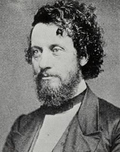 |
Arthur MacArthur Sr. (1815–1896) [35][37] |
March 21, 1856[38] – March 25, 1856 (removed from office)[i] |
Democratic[28] | Acting as governor | |||
| 5 |  |
Coles Bashford (1816–1878) [36][39] |
March 25, 1856[40] – January 4, 1858 (did not run) |
Republican[28] | Arthur MacArthur Sr.[h] | |||
| 6 |  |
Alexander Randall (1819–1872) [41][42] |
January 4, 1858[43] – January 6, 1862 (did not run) |
Republican[28] | 1857 | Erasmus D. Campbell[h] | ||
| 1859 | Butler Noble | |||||||
| 7 | 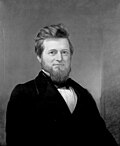 |
Louis P. Harvey (1820–1862) [44][45] |
January 6, 1862[46] – April 19, 1862 (died in office) |
Republican[28] | 1861 | Edward Salomon | ||
| 8 |  |
Edward Salomon (1828–1909) [47][48] |
April 19, 1862[49] – January 4, 1864 (lost nomination)[50] |
Republican[28] | Succeeded from lieutenant governor |
Vacant | ||
| 9 | 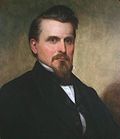 |
James T. Lewis (1819–1904) [51][52] |
January 4, 1864[53] – January 1, 1866 (did not run) |
Republican[28] | 1863 | Wyman Spooner | ||
| 10 |  |
Lucius Fairchild (1831–1896) [54][55] |
January 1, 1866[56] – January 1, 1872 (did not run) |
Republican[28] | 1865 | |||
| 1867 | ||||||||
| 1869 | Thaddeus C. Pound | |||||||
| 11 |  |
Cadwallader C. Washburn (1818–1882) [57][58] |
January 1, 1872[59] – January 5, 1874 (lost election) |
Republican[28] | 1871 | Milton Pettit (died March 23, 1873) | ||
| Vacant | ||||||||
| 12 |  |
William Robert Taylor (1820–1909) [60][61] |
January 5, 1874[62] – January 3, 1876 (lost election) |
Reform[63] | 1873 | Charles D. Parker[h] | ||
| 13 |  |
Harrison Ludington (1812–1891) [64][65] |
January 3, 1876[66] – January 7, 1878 (did not run)[64] |
Republican[28] | 1875 | |||
| 14 |  |
William E. Smith (1824–1883) [67][68] |
January 7, 1878[69] – January 2, 1882 (did not run) |
Republican[28] | 1877 | James M. Bingham | ||
| 1879 | ||||||||
| 15 |  |
Jeremiah McLain Rusk (1830–1893) [70][71] |
January 2, 1882[72] – January 7, 1889 (did not run) |
Republican[28] | 1881 | Sam Fifield | ||
| 1884 | ||||||||
| 1886 | George Washington Ryland | |||||||
| 16 |  |
William D. Hoard (1836–1918) [73][74] |
January 7, 1889[75] – January 5, 1891 (lost election) |
Republican[28] | 1888 | |||
| 17 |  |
George Wilbur Peck (1840–1916) [76][77] |
January 5, 1891[78] – January 7, 1895 (lost election) |
Democratic[28] | 1890 | Charles Jonas (resigned April 4, 1894) | ||
| 1892 | ||||||||
| Vacant | ||||||||
| 18 |  |
William H. Upham (1841–1924) [79][80] |
January 7, 1895[81] – January 4, 1897 (did not run)[79] |
Republican[28] | 1894 | Emil Baensch | ||
| 19 |  |
Edward Scofield (1842–1925) [82][83] |
January 4, 1897[84] – January 7, 1901 (did not run) |
Republican[28] | 1896 | |||
| 1898 | Jesse Stone (died May 11, 1902) | |||||||
| 20 |  |
Robert M. La Follette (1855–1925) [85][86] |
January 7, 1901[87] – January 1, 1906 (resigned)[k] |
Republican[28] | 1900 | |||
| Vacant | ||||||||
| 1902 | James O. Davidson | |||||||
| 1904 | ||||||||
| 21 |  |
James O. Davidson (1854–1922) [88][89] |
January 1, 1906[90] – January 2, 1911 (did not run) |
Republican[28] | Succeeded from lieutenant governor |
Vacant | ||
| 1906 | William D. Connor | |||||||
| 1908 | John Strange | |||||||
| 22 |  |
Francis E. McGovern (1866–1946) [91][92] |
January 2, 1911[93] – January 4, 1915 (did not run)[l] |
Republican[28] | 1910 | Thomas Morris | ||
| 1912 | ||||||||
| 23 |  |
Emanuel L. Philipp (1861–1925) [94][95] |
January 4, 1915[96] – January 3, 1921 (did not run) |
Republican[28] | 1914 | Edward Dithmar | ||
| 1916 | ||||||||
| 1918 | ||||||||
| 24 |  |
John J. Blaine (1875–1934) [97][98] |
January 3, 1921[99] – January 3, 1927 (did not run)[m] |
Republican[28] | 1920 | George Comings | ||
| 1922 | ||||||||
| 1924 | Henry Huber | |||||||
| 25 |  |
Fred R. Zimmerman (1880–1954) [100][101] |
January 3, 1927[102] – January 7, 1929 (lost nomination)[100] |
Republican[28] | 1926 | |||
| 26 |  |
Walter J. Kohler Sr. (1875–1940) [103][104] |
January 7, 1929[105] – January 5, 1931 (lost nomination)[103] |
Republican[28] | 1928 | |||
| 27 |  |
Philip La Follette (1897–1965) [106][107] |
January 5, 1931[108] – January 2, 1933 (lost nomination)[n] |
Republican[28] | 1930 | |||
| 28 |  |
Albert G. Schmedeman (1864–1946) [109][110] |
January 2, 1933[111] – January 7, 1935 (lost election) |
Democratic[28] | 1932 | Thomas J. O'Malley[h] (died May 27, 1936) | ||
| 29 |  |
Philip La Follette (1897–1965) [106][107] |
January 7, 1935[112] – January 2, 1939 (lost election) |
Progressive[28] | 1934 | |||
| Vacant | ||||||||
| 1936 | Henry Gunderson (resigned October 16, 1937) | |||||||
| Vacant | ||||||||
| Herman Ekern (appointed May 16, 1938) | ||||||||
| 30 |  |
Julius P. Heil (1876–1949) [113][114] |
January 2, 1939[115] – January 4, 1943 (lost election) |
Republican[28] | 1938 | Walter Samuel Goodland[j] | ||
| 1940 | ||||||||
| — |  |
Orland Steen Loomis (1893–1942) [116] |
Died before taking office |
Progressive[28] | 1942[o] | |||
| 31 | 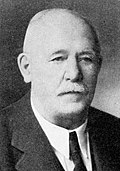 |
Walter Samuel Goodland (1862–1947) [117][118] |
January 4, 1943[119] – March 12, 1947 (died in office) |
Republican[28] | Succeeded from lieutenant governor |
Vacant | ||
| 1944 | Oscar Rennebohm | |||||||
| 1946 | ||||||||
| 32 |  |
Oscar Rennebohm (1889–1968) [120][121] |
March 12, 1947[122] – January 1, 1951 (did not run)[120] |
Republican[28] | Succeeded from lieutenant governor |
Vacant | ||
| 1948 | George M. Smith | |||||||
| 33 | Walter J. Kohler Jr. (1904–1976) [123][124] |
January 1, 1951[125] – January 7, 1957 (did not run)[123] |
Republican[28] | 1950 | ||||
| 1952 | ||||||||
| 1954 | Warren P. Knowles | |||||||
| 34 |  |
Vernon Wallace Thomson (1905–1988) [126][127] |
January 7, 1957[128] – January 5, 1959 (lost election) |
Republican[28] | 1956 | |||
| 35 |  |
Gaylord Nelson (1916–2005) [129][130] |
January 5, 1959[131] – January 7, 1963 (did not run)[129] |
Democratic[28] | 1958 | Philleo Nash | ||
| 1960 | Warren P. Knowles[j] | |||||||
| 36 |  |
John W. Reynolds Jr. (1921–2002) [132][133] |
January 7, 1963[134] – January 4, 1965 (lost election) |
Democratic[28] | 1962 | Jack B. Olson[j] | ||
| 37 |  |
Warren P. Knowles (1908–1993) [135][136] |
January 4, 1965[137] – January 4, 1971 (did not run)[135] |
Republican[28] | 1964 | Patrick Lucey[h] | ||
| 1966 | Jack B. Olson | |||||||
| 1968 | ||||||||
| 38 |  |
Patrick Lucey (1918–2014) [138][139] |
January 4, 1971[140] – July 6, 1977 (resigned)[p] |
Democratic[28] | 1970 | Martin J. Schreiber | ||
| 1974 | ||||||||
| 39 |  |
Martin J. Schreiber (b. 1939) [141][142] |
July 6, 1977[143] – January 3, 1979 (lost election) |
Democratic[142] | Succeeded from lieutenant governor |
Vacant | ||
| 40 | 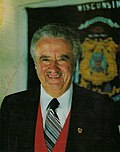 |
Lee S. Dreyfus (1926–2008) [144] |
January 3, 1979[145] – January 3, 1983 (did not run) |
Republican[144] | 1978 | Russell Olson | ||
| 41 |  |
Tony Earl (1936–2023) [146] |
January 3, 1983[147] – January 5, 1987 (lost election) |
Democratic[146] | 1982 | James Flynn | ||
| 42 |  |
Tommy Thompson (b. 1941) [148] |
January 5, 1987[149] – February 1, 2001 (resigned)[q] |
Republican[148] | 1986 | Scott McCallum | ||
| 1990 | ||||||||
| 1994 | ||||||||
| 1998 | ||||||||
| 43 |  |
Scott McCallum (b. 1950) [150] |
February 1, 2001[151] – January 6, 2003 (lost election) |
Republican[150] | Succeeded from lieutenant governor |
Vacant | ||
| Margaret Farrow (appointed May 9, 2001) | ||||||||
| 44 |  |
Jim Doyle (b. 1945) [152] |
January 6, 2003[153] – January 3, 2011 (did not run) |
Democratic[152] | 2002 | Barbara Lawton | ||
| 2006 | ||||||||
| 45 | 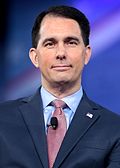 |
Scott Walker (b. 1967) [154] |
January 3, 2011[155] – January 7, 2019 (lost election) |
Republican[154] | 2010 | Rebecca Kleefisch | ||
| 2012 (recall) | ||||||||
| 2014 | ||||||||
| 46 |  |
Tony Evers (b. 1951) [156] |
January 7, 2019[157] – Incumbent[r] |
Democratic[156] | 2018 | Mandela Barnes | ||
| 2022 | Sara Rodriguez | |||||||
See also
Notes
- Tallmadge was nominated and confirmed by the Senate on June 15, 1844.[20]
- A convention of Free Soilers and others nominated Farwell, but he declined.[29]
- Represented the Democratic Party
- The 1855 election was very close, with Barstow initially named the winner by the Democratic state canvassing board, but irregularities were found and Republicans challenged it to the Supreme Court. Barstow resigned on March 21, before the Supreme Court could reach a decision.[32] Lieutenant Governor MacArthur then acted as governor, though there was uncertainty as to the legitimacy of his position; this was complicated further when the Supreme Court ruled on March 25 that Bashford was the winner. Bashford arrived at the capitol and, due to fears of violence, MacArthur did not resist.[35] The legislature recognized Bashford as governor on March 27.[36]
- Represented the Republican Party
- La Follette resigned, having been elected to the United States Senate for a term beginning March 4, 1905; he delayed his resignation for nine months.[28]
- McGovern instead ran unsuccessfully for the United States Senate.[91]
- Blaine was instead elected to the United States Senate.[97]
- La Follette lost the Republican nomination to Walter J. Kohler Sr.[106]
- Loomis was elected in the 1942 election, but died before taking office. Per a ruling of the Wisconsin Supreme Court, Goodland, who had been re-elected lieutenant governor in the same election, served as governor term.[117]
- Lucey resigned, having been confirmed as United States Ambassador to Mexico.[138]
- Thompson resigned, having been confirmed as United States Secretary of Health and Human Services.[148]
- Evers' second term began on January 3, 2023,[158] and will expire on January 4, 2027.
References
External links
Wikiwand - on
Seamless Wikipedia browsing. On steroids.


